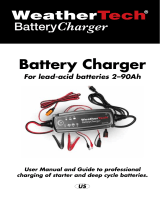
• 13 •
4. UBICACIÓN DEL CARGADOR
4.1 Ubique el cargador a la mayor distancia posible de la batería como lo permitan los cables de CC.
4.2 Nunca ubique el cargador directamente por encima de la batería que se carga; los gases de la batería
corroerán y dañarán el cargador.
4.3 Nunca permita que el ácido de la batería gotee sobre el cargador al leer el peso especíco del electrolito
o al cargar la batería.
4.4 No utilice el cargador en un área cerrada o restrinja la ventilación en cualquier forma.
4.5 No ubique la batería encima del cargador.
5. PRECAUCIONES DE CONEXIÓN EN CC
5.1 Conecte y desconecte las pinzas de salida CC. sólo después de haber establecido todos los interruptores
del cargador a la posición de “apagado” (si es aplicable) y de haber desconectado el enchufe de C.A. del
tomacorriente eléctrico. Nunca junte las pinzas de batería cuando el cargador está conectado. Las pinzas
están energizadas y pueden producir chispas.
5.2 Sujete las pinzas a la batería y al chasis, como se indica en en las secciones 6 y 7.
6. SIGA ESTOS PASOS CUANDO LA BATERÍA ESTÉ COLOCADA EN EL VEHÍCULO
ADVERTENCIA:
UNA CHISPA PROVOCADA CERCA DE LA BATERÍA PUEDE CAUSAR LA EXPLOSIÓN DE LA
BATERÍA. PARA REDUCIR EL RIESGO DE PROVOCAR CHISPAS CERCA DE LA BATERÍA:
6.1 Ubique los cables de C.A. y C.C. para reducir el riesgo de daños a la cubierta, a la puerta y a las piezas
móviles o calientes del motor.
6.2 Manténgase alejado de las paletas del ventilador, correas, poleas y otras piezas que podrían provocar lesiones.
6.3 Verique la polaridad de los bornes de la batería. El borne POSITIVO (POS, P, +) de la batería
generalmente posee un diámetro mayor al borne NEGATIVO (NEG, N, -).
6.4 Determine qué borne de la batería hace descarga a tierra (se encuentra conectado) con el chasis. Si el
borne negativo hace descarga a tierra con el chasis (como en la mayor parte de los vehículos), ver el
paso (6.5). Si el borne positivo hace descarga a tierra con el chasis, ver el paso (6.6).
6.5 En un vehículo con descarga a tierra por borne negativo, conecte el gancho POSITIVO (ROJO) del
cargador de batería al borne POSITIVO (POS, P, +) sin descarga a tierra de la batería. Conecte el
gancho NEGATIVO (NEGRO) al chasis del vehículo o al bloque motor alejado de la batería. No conecte
el gancho al carburador, líneas de combustible o cuerpos metálicos. Conecte a una pieza metálica de
calibre grueso del marco o del bloque motor.
6.6 En un vehículo con descarga a tierra por borne positivo, conecte el gancho NEGATIVO (NEGRO)
del cargador de batería al borne NEGATIVO (NEG, N, -) sin descarga a tierra de la batería. Conecte el
gancho POSITIVO (ROJO) al chasis del vehículo o al bloque motor alejado de la batería. No conecte al
carburador, líneas de combustible o cuerpos metálicos. Conecte a una pieza metálica de calibre grueso
del marco o del bloque motor.
6.7 Al desconectar el cargador, apague todos los interruptores (en su caso), desconecte el cable de C.A., retire
el gancho del chasis del vehículo y luego retire el gancho del terminal perteneciente a la batería.
6.8 Vea Cálculo de Tiempo de Carga para duración de la carga.
7. SIGA ESTOS PASOS CUANDO LA BATERÍA SE ENCUENTRE FUERA DEL VEHÍCULO
ADVERTENCIA:
UNA CHISPA PROVOCADA CERCA DE LA BATERÍA PUEDE CAUSAR LA EXPLOSIÓN DE LA
BATERÍA. PARA REDUCIR EL RIESGO DE PROVOCAR CHISPAS CERCA DE LA BATERÍA:
7.1 Verique la polaridad de los bornes de la batería. El borne POSITIVO (POS, P, +) de la batería
generalmente posee un diámetro mayor al borne NEGATIVO (NEG, N, -).
7.2 Sujete al menos un cable aislado de batería de 24 pulgadas (61 cm) de largo con calibre 6 según el Calibre
americano de cables (AWG, por sus siglas en inglés) al borne NEGATIVO (NEG, N, -) de la batería.




















